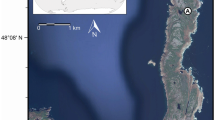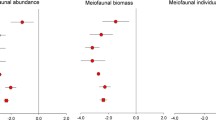Abstract
Penguin colony is one of the Earth’s simplest ecosystems. As the seabird with the largest population in Antarctica, penguin is a unique indicator of Antarctic environment and climate changes. In this study, we collected an ornithogenic sediment core from Gardner Island in Vestfold Hills, East Antarctica, reconstructed an 8,500 years variation history of penguin population and vegetation abundance on this island, and examined the evolution of the penguin colony. We used the levels of two molecular markers cholesterol and cholestanol as the proxy indicators of penguin population size. Other molecular markers, including C24:0 alkenoic acid, C18 n-alkanol and phytol were used as the proxy indicators of aquatic moss, algae, and general vegetation, respectively. It is shown that the growth of algae was mainly affected by the nutritional supply from penguin droppings, so their abundance was positively linked with penguin population. The growth of aquatic moss, however, was controlled more by the degree of water body transparency than by nutrient availability. Because the pollution of water body increased as penguin population grew, aquatic moss abundance showed a seesaw-like relationship with penguin population. These results suggested that penguins played a dominant role in this simple ecosystem in the Antarctic environment. The reconstructed relationship between penguin population and vegetation abundance may offer new insights to understand ancient Antarctic environment and ecology.




Similar content being viewed by others
References
Adamson DA, Pickard J (1986) Cainozoic history of the Vestfold Hills. In: Pickard J (ed) Antarctic oasis. Academic Press, Sydney, pp 63–97
Ainley DG (2002) The Adelie penguin: bellwether of climate change. Columbia University Press, New York
Baroni C, Orombelli G (1994) Abandoned penguin rookeries as Holocene paleoclimatic indicators in Antarctica. Geology 22:23–26
Bird MI, Chivas AR, Radnell CJ, Burton HR (1991) Sedimentological and stable-isotope evolution of lakes in the Vestfold Hills, Antarctica. Palaeogeogr Palaeoclimatol Palaeoecol 84:109–130
Bull ID, Lockheart MJ, Elhmmali MM, Roberts DJ, Evershed RP (2002) The origin of faeces by means of biomarker detection. Environ Int 27:647–654
Coolen MJL, Hopmans EC, Rijpstra WIC, Muyzer G, Schouten S, Volkman JK, Damste JSS (2004) Evolution of the methane cycle in Ace Lake (Antarctica) during the Holocene: response of methanogens and methanotrophs to environmental change. Org Geochem 35:1151–1167
Domack EW, Jull AJT, Nakao S (1991) Advance of East Antarctic outlet glaciers during the Hypsithermal—implications for the volume state of the Antarctic ice-sheet under global warming. Geology 19:1059–1062
Ellis JC (2005) Marine birds on land: a review of plant biomass, species richness, and community composition in seabird colonies. Plant Ecol 181:227–241
Emslie SD (2001) Radiocarbon dates from abandoned penguin colonies in the Antarctic Peninsula region. Antarct Sci 13:289–295
Emslie SD, Woehler EJ (2005) A 9000-year record of Adelie penguin occupation and diet in the Windmill Islands, East Antarctica. Antarct Sci 17:57–66
Emslie SD, Berkman PA, Ainley DG, Coats L, Polito M (2003) Late-Holocene initiation of ice-free ecosystems in the southern Ross Sea, Antarctica. Mar Ecol Prog Ser 262:19–25
Fitzsimons SJ, Colhoun EA (1995) Form, structure and stability of the margin of the Antarctic ice-sheet, Vestfold Hills and Bunger Hills, East Antarctica. Antarct Sci 7:171–179
Fitzsimons SJ, Domack EW (1993) Evidence for Early Holocene deglaciation of the Vestfold Hills, east Antarctica. Polar Rec 29:237–240
Fraser WR, Trivelpiece WZ, Ainley DG, Trivelpiece SG (1992) Increases in Antarctic penguin populations—reduced competition with whales or a loss of sea ice due to environmental warming. Polar Biol 11:525–531
Fulford-Smith SP, Sikes EL (1996) The evolution of Ace Lake, Antarctica, determined from sedimentary diatom assemblages. Palaeogeogr Palaeoclimatol Palaeoecol 124:73–86
Hodgson DA, Roberts D, McMinn A, Verleyen E, Terry B, Corbett C, Vyverman W (2006) Recent rapid salinity rise in three East Antarctic lakes. J Paleolimnol 36:385–406
Huang T, Sun LG, Wang YH, Liu XD, Zhu RB (2009a) Penguin population dynamics for the past 8500 years at Gardner Island, Vestfold Hills. Antarct Sci 21:571–578
Huang T, Sun LG, Wang YH, Zhu RB (2009b) Penguin occupation in the Vestfold Hills. Antarct Sci 21:131–134
McMinn A, Hejnis H, Harle K, McOrist G (2001) Late-Holocene climate change recorded in sediment cores from Ellis Fjord, eastern Antarctica. Holocene 11:291–300
Meyers PA (2003) Applications of organic geochemistry to paleolimnological reconstructions: a summary of examples from the Laurentian Great Lakes. Org Geochem 34:261–289
Montague TL (1988) Birds of Prydz Bay, Antarctica: distribution and abundance. Hydrobiologia 165:227–237
Olafur I, Christian H, Paul AB, Svante B, Eric C, Ian DG, Brenda H, Kazuomi H, Martin M, Per M, Michael LP (1998) Antarctic glacial history since the Last Glacial Maximum: an overview of the record on land. Antarct Sci 10:326–344
Pickard J, Seppelt RD (1984) Holocene occurrence of the moss Bryum algens Card. in the Vestfold Hills, Antarctica. J Bryol 13:209–217
Quilty PG (2006) Landform evolution in the Marine Plain region, Vestfold Hills, East Antarctica. Antarct Sci 18:239–259
Rathburn AE, Pichon JJ, Ayress MA, DeDeckker P (1997) Microfossil and stable-isotope evidence for changes in Late Holocene palaeoproductivity and palaeoceanographic conditions in the Prydz Bay region of Antarctica. Palaeogeogr Palaeoclimatol Palaeoecol 131:485–510
Roberts D, McMinn A (1996) Relationships between surface sediment diatom assemblages and water chemistry gradients in saline lakes of the Vestfold Hills, Antarctica. Antarct Sci 8:331–341
Roberts D, McMinn A (1998) A weighted-averaging regression and calibration model for inferring lake water salinity from fossil diatom assemblages in saline lakes of the Vestfold hills: a new tool for interpreting Holocene lake histories in Antarctica. J Paleolimnol 19:99–113
Roberts D, van Ommen TD, McMinn A, Morgan V, Roberts JL (2001) Late-Holocene East Antarctic climate trends from ice-core and lake-sediment proxies. Holocene 11:117–120
Rontani JF, Volkman JK (2003) Phytol degradation products as biogeochemical tracers in aquatic environments. Org Geochem 34:1–35
Seppelt RD, Broady PA, Pickard J, Adamson DA (1988) Plants and landscape in the Vestfold Hills, Antarctica. Hydrobiologia 165:185–196
Sun LG, Xie ZQ (2001) Relics: penguin population programs. Sci Prog 84:31–44
Sun LG, Xie ZQ, Zhao JL (2000) Palaeoecology—a 3,000-year record of penguin populations. Nature 407:858
Tatur A, Myrcha A, Niegodzisz J (1997) Formation of abandoned penguin rookery ecosystems in the maritime Antarctic. Polar Biol 17:405–417
Taylor F, McMinn A (2001) Evidence from diatoms for Holocene climate fluctuation along the East Antarctic margin. Holocene 11:455–466
Venkatesan MI, Santiago CA (1989) Sterols in ocean sediment: novel tracers to examine habitats of cetaceans, pinnipeds, penguins and humans. Mar Biol 102:431–437
Wagner B, Seppelt R (2006) Deep-water occurrence of the moss Bryum pseudotriquetrum in Radok Lake, Amery Oasis, East Antarctica. Polar Biol 29:791–795
Wang Z, Patrick PD, Paul AB (2001) Sea level change and environmental evolution of coastal lakes in Vestfold Hills, Antarctica. Chin J Polar Sci 13:69–81 (in Chinese with English abstract)
Wang JJ, Wang YH, Wang XM, Sun LG (2007) Penguins and vegetations on Ardley Island, Antarctica: evolution in the past 2,400 years. Polar Biol 30:1475–1481
Whitehead MD, Johnstone GW (1990) The distribution and estimated abundance of Adélie penguin breeding in Prydz Bay, Antarctica. Proc NIPR Symp Polar Biol 3:91–98
Woehler EJ, Johnstone GW (1991) Status and conservation of seabirds of the Australian Antarctic Territory. In: Croxall JP (ed) Seabird status and conservation: a supplement, vol 11. ICBP Technical Publication, Cambridge, pp 279–308
Woehler EJ, Tierney TJ, Burton HR (1989) The distribution and abundance of Adelie penguin, Pygoscelis adeliae, at the Vestfold Hills. ANARE Res Notes 70:1–41
Zhang QS (1992) Late Quaternary environmental changes in the Antarctic and their correlation with global change. In: Yoshida Y, Kaminuma K, Shiraishi K (eds) Recent progress in Antarctic Earth Science. Terra Scientific Publishing Company, Tokyo, pp 781–785
Zhang G, Sheng GY, Peng PA, Zheng HH (2000) Molecular organic geochemical peculiarities of lacustrine core sediments in Fildes Peninsula, King George Island, Antarctica. Chin Sci Bull 45:67–70 (in Chinese with English abstract)
Zwartz D, Bird M, Stone J, Lambeck K (1998) Holocene sea-level change and ice-sheet history in the Vestfold Hills, East Antarctica. Earth Planet Sci Lett 155:131–145
Acknowledgments
We thank the Chinese Arctic and Antarctic Administration, Australian Antarctic Division, CHINARE22 team in Zhongshan Station and the members of Davis Station for their support and assistance in the field working. We thank Prof. Renbin Zhu for sample collection. This study was funded by the National Natural Science Foundation of China (No. 40730107), the National Science and Technology Supporting Program (2006BAB18B07), the State Key Laboratory of Organic Geochemistry foundation (OGL-200606) and the Australia Antarctic Division Science Project (AAD2873).
Author information
Authors and Affiliations
Corresponding author
Rights and permissions
About this article
Cite this article
Huang, J., Sun, L., Huang, W. et al. The ecosystem evolution of penguin colonies in the past 8,500 years on Vestfold Hills, East Antarctica. Polar Biol 33, 1399–1406 (2010). https://doi.org/10.1007/s00300-010-0832-x
Received:
Revised:
Accepted:
Published:
Issue Date:
DOI: https://doi.org/10.1007/s00300-010-0832-x




